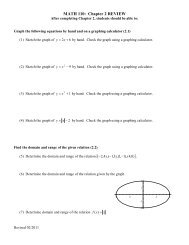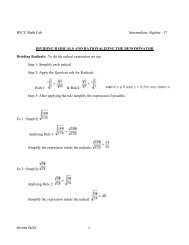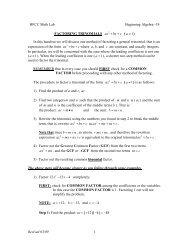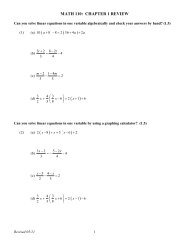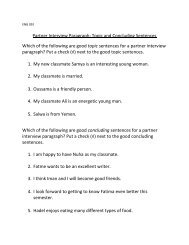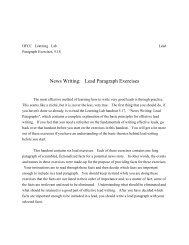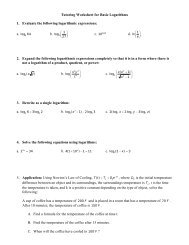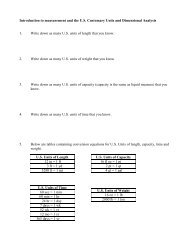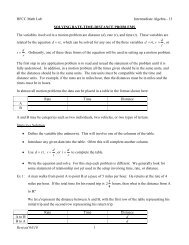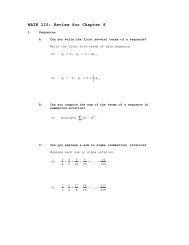Basic Coordinating Conjunctions - The Learning Lab at HFCC
Basic Coordinating Conjunctions - The Learning Lab at HFCC
Basic Coordinating Conjunctions - The Learning Lab at HFCC
Create successful ePaper yourself
Turn your PDF publications into a flip-book with our unique Google optimized e-Paper software.
<strong>Basic</strong> <strong>Coordin<strong>at</strong>ing</strong> <strong>Conjunctions</strong>IntroductionA coordin<strong>at</strong>ing conjunction is a word which joins together two clauses which are bothequally important. This page will explain the most common coordin<strong>at</strong>ing conjunctionsand how to use them.1. Wh<strong>at</strong> is a clause?A clause is a unit which contains a subject and a verb. For example, “It was raining” is aclause; the subject is “it”, and the verb is “was raining”. Every sentence MUST contain <strong>at</strong>least one clause, but it may contain more than one. For example:It was raining, so I took my umbrella.This sentence contains two clauses, “It was raining” and “I took my umbrella”. <strong>The</strong>y areindependent clauses because each one would be a good sentence on its own — eachone is a “complete thought”.2. Joining clauses together with coordin<strong>at</strong>ing conjunctionsExamine the example sentence one more time:It was raining, so I took my umbrella.<strong>The</strong> two clauses in the sentence are joined together with the word “so”. This is acoordin<strong>at</strong>ing conjunction. It is used to join two independent clauses which are equallyimportant. A coordin<strong>at</strong>ing conjunction usually comes in the middle of a sentence, andit usually follows a comma (unless both clauses are very short). <strong>The</strong>se are the mostimportant coordin<strong>at</strong>ing conjunctions:Conjunction Function Exampleandjoins two similar ideas togetherHe lives in Victoria, and hestudies <strong>at</strong> UVic.but joins two contrasting ideas John is Canadian, but Sally is
Conjunction Function ExampleEnglish.orjoins two altern<strong>at</strong>ive ideasI could cook some supper, or wecould order a pizza.soshows th<strong>at</strong> the second idea isthe result of the firstShe was sick, so she went to thedoctor.<strong>The</strong>se conjunctions are also used:nor (joining two neg<strong>at</strong>ive altern<strong>at</strong>ives)for (meaning “because”)yet (meaning “but”)3. Using coordin<strong>at</strong>ing conjunctions<strong>The</strong>re are three things to remember when using coordin<strong>at</strong>ing conjunctions:1. <strong>Coordin<strong>at</strong>ing</strong> conjunctions join independent clauses. Each clause must be a“complete thought” which could be a sentence on its own.2. With coordin<strong>at</strong>ing conjunctions, put the conjunction in the middle. Youmay see some sentences starting with “but” or “and”, but this is usually wrong,so it's best to avoid it.3. With coordin<strong>at</strong>ing conjunctions, use a comma unless both clauses are veryshort.




